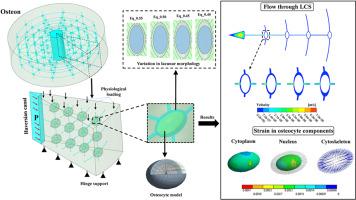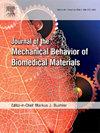Evaluating the influence on osteocyte mechanobiology within the lacunar-canalicular system for varying lacunar equancy and perilacunar elasticity: A multiscale fluid-structure interaction analysis
IF 3.3
2区 医学
Q2 ENGINEERING, BIOMEDICAL
Journal of the Mechanical Behavior of Biomedical Materials
Pub Date : 2024-10-04
DOI:10.1016/j.jmbbm.2024.106767
引用次数: 0
Abstract
The lacunar morphology and perilacunar tissue properties of osteocytes in bone can vary under different physiological and pathological conditions. How these alterations collectively change the overall micromechanics of osteocytes in the lacunar-canalicular system (LCS) of an osteon still requires special focus. Therefore, a Haversian canal and LCS-based osteon model was established to evaluate the changes in the hydrodynamic environment around osteocytes under physiological loading using fluid-structure interaction analysis, followed by a sub-modelled finite element analysis to assess the mechanical responses of osteocytes and their components. Osteocytes were modelled with detailed configurations, including cytoplasm, nucleus, and cytoskeleton, and parametric variations in lacunar equancy (L.Eq) and perilacunar elasticity (Pl.E) were considered within the osteon model. The study aimed to conduct a comparative study among osteon models with varying L. Eq and Pl. E to check the resulting differences in osteocyte mechanobiology. The results demonstrated that the average mechanical stimulation of each subcellular component of osteocytes increased with decreases in L. Eq and Pl. E, reflecting conditions typically seen in young, healthy bone as per previous literature. However, hydrodynamic responses, such as fluid flow and fluid shear stress on osteocytes, varied proportionally with the elasticity difference between the bone matrix and the perilacunar region during Pl. E variation. Additionally, the findings revealed that a minimal percentage of energy was used to transmit mechanical responses through microtubules from the cell membrane to the nucleus, and this energy percentage increased with higher L. Eq. The outcomes of the study could help to quantify how the osteocyte microenvironment and its mechanosensitivity within cortical bone changes with L. Eq and Pl. E alterations in different bone conditions, from young to aged and healthy to diseased.

评估不同裂隙等度和裂隙周围弹性对裂隙-椎管系统内骨细胞机械生物学的影响:多尺度流体-结构相互作用分析。
在不同的生理和病理条件下,骨中骨细胞的腔隙形态和周围组织特性会发生变化。这些变化如何共同改变骨小梁的腔隙-椎管系统(LCS)中骨细胞的整体微观力学,仍然需要特别关注。因此,我们建立了一个基于哈弗斯管和 LCS 的成骨细胞模型,利用流体-结构相互作用分析评估生理负荷下成骨细胞周围流体动力环境的变化,然后进行子模型有限元分析以评估成骨细胞及其组成部分的机械响应。对骨细胞进行了详细的构型建模,包括细胞质、细胞核和细胞骨架,并在骨细胞模型中考虑了裂隙均衡性(L.Eq)和围裂隙弹性(Pl.E)的参数变化。研究旨在对不同 L. Eq 和 Pl.E 的成骨细胞模型进行比较研究,以检查由此产生的成骨细胞机械生物学差异。结果表明,随着 L. Eq 和 Pl.E,反映了以往文献中年轻健康骨骼的典型情况。然而,流体动力反应,如骨细胞上的流体流动和流体剪切应力,在 Pl.E 变化。此外,研究结果表明,通过微管将机械响应从细胞膜传递到细胞核所使用的能量比例极小,而这种能量比例随着 L. Eq 的升高而增加。研究结果有助于量化骨细胞微环境及其在皮质骨中的机械敏感性如何随着 L. Eq 和 Pl.E 的变化。
本文章由计算机程序翻译,如有差异,请以英文原文为准。
求助全文
约1分钟内获得全文
求助全文
来源期刊

Journal of the Mechanical Behavior of Biomedical Materials
工程技术-材料科学:生物材料
CiteScore
7.20
自引率
7.70%
发文量
505
审稿时长
46 days
期刊介绍:
The Journal of the Mechanical Behavior of Biomedical Materials is concerned with the mechanical deformation, damage and failure under applied forces, of biological material (at the tissue, cellular and molecular levels) and of biomaterials, i.e. those materials which are designed to mimic or replace biological materials.
The primary focus of the journal is the synthesis of materials science, biology, and medical and dental science. Reports of fundamental scientific investigations are welcome, as are articles concerned with the practical application of materials in medical devices. Both experimental and theoretical work is of interest; theoretical papers will normally include comparison of predictions with experimental data, though we recognize that this may not always be appropriate. The journal also publishes technical notes concerned with emerging experimental or theoretical techniques, letters to the editor and, by invitation, review articles and papers describing existing techniques for the benefit of an interdisciplinary readership.
 求助内容:
求助内容: 应助结果提醒方式:
应助结果提醒方式:


